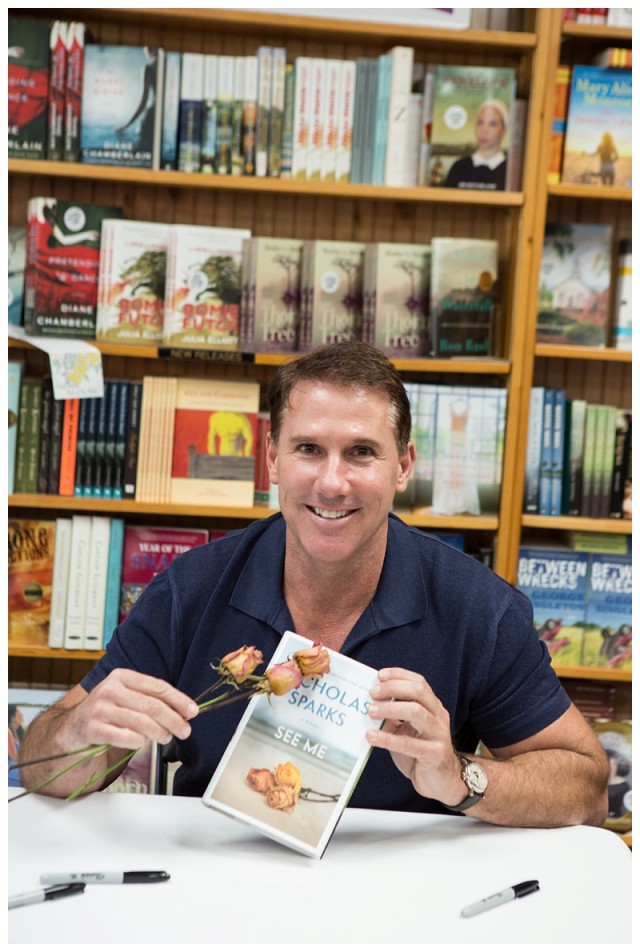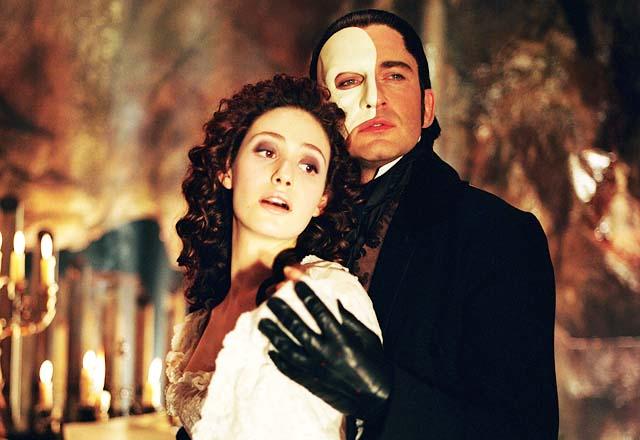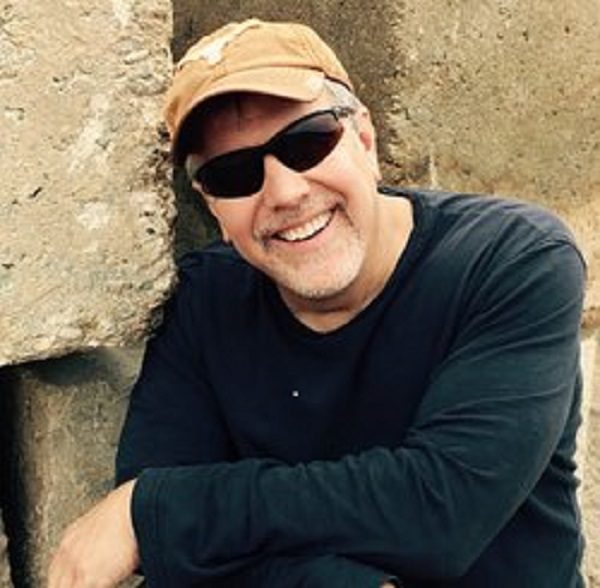
Source: Wikimedia
The recent successes of popular dystopian trilogies, The Hunger Games, The Maze Runner, and Divergent and post-apocalyptic zombie comic-book- turned-TV series, The Walking Dead, it seems that the dystopian genre and similar cross genres are taking center stage in the book world. Among the tens of thousands of authors vying for recognition in a thriving indie market, one author of incredible talent is emerging as “The Next Post-Apocalyptic King.”
His most popular series, Slow Burn is a unique take on the zombie theme, and is gaining momentum on Amazon with thousands of five-star reviews and nearly a million copies sold. He creates a completely believable dystopian world with insanely flawed, but lovable protagonists, villains that are scarily realistic, and a style that exudes witticism.
I was honored with the opportunity to ask him some questions about his books and dig into the unabashedly perverse and witty mind of Bobby Adair, The Next Post-Apocalyptic King.
ADH: I’ve titled my article “Bobby Adair: The Next Post-Apocalyptic King,” because you have this brilliant ability to create authentic feeling post-apocalyptic societies in all of your books. What gives you inspiration when creating these settings?
BA: I don’t know that inspiration is the right word for what I do. I think I’ve always been a little too indulgent with my daydreams, maybe I was bored with school as a kid, maybe I had a natural tendency to want to escape, I don’t know, But when I decide to write a book, it’s pretty easy to just start daydreaming about the general subject matter I’m interested in, whether it’s zombies, an ebola epidemic, or some distant post-apocalyptic future, and then wait until my ideas start to coalesce around something interesting.
Having said that, there was an impetus for the Slow Burn series and the Ebola series. I guess that might be true of The Last Survivors as well. For Slow Burn, I’d always wanted to write a zombie book, I just never did until I was reading one once on a drive through the mountains and complaining to my (now) wife that I could write something bettter. She said, “Why don’t you?” I went home that day and wrote out a few chapters that I liked. That was maybe three years ago. Now that series has nine books and has sold nearly a million copies.
Ebola K grew out of some experiences my son had while volunteering at a school for orphans in Africa, but because my mind is a little twisted, it turned into a pandemic story.
The Last Survivors grew out of a series of conversations I had with Piperbrook after he approached me about collaborating on something.
ADH: What sets your Slow Burn series apart from other Zombie books?
BA: I don’t read that many zombie or post-apocalyptic books so I can’t say that I’m an expert on the genre, though I did read quite a few prior to and during the writing of Slow Burn…market research, you know. If something sets Slow Burn apart, I’d say it’s the dark humor and the deeply personal nature of the characters’ stories, especially the two main characters, Zed and Murphy. In trying to fill the books with all the zombie action the genre’s readers expect, I also want my readers to feel the grief of loss that comes when a character dies…I think that is it in a nutshell. I don’t want my books to give readers an adrenaline rush only. I want the readers to experience a full range of emotions. I want them to laugh, to cry, to be afraid to turn out the light. I want them to bite their nails in anticipation and I want their hearts to race.
ADH: In the forward to Slow Burn: Grind (Book 8), you say that the main characters of the series, Zed and Murphy are your favorite to write. What makes them your favorite?
BA: Complexity. I’ve spent enough time with these two characters that they’re just like fully fleshed out, real people to me. They have flaws. They make mistakes. But they’re both good people trying to do the right thing and learning about themselves along the way. They both have deep back stories, and they have emotional connections to the other characters. I guess in a way, I’ve been through a lot with these two guys, a lot of traumatic events. They’re the kinds of shared experiences that bond real people together for life. So if Zed and Murphy weren’t imaginary, we’d be lifelong friends at this point.
ADH: In book seven of the series, Zed and Murphy drive a 1968 Mustang with an electric engine, hoping to move quietly through the zombie horde. Your website says this is an actual vehicle made by a company in Austin, TX where you live. Have they let you drive it yet?
BA: No, but Kat and I have both ridden in it. We moved to Austin right around the time I was finishing up work on Slow Burn 7, where the Zombie 222 first appears. I’d read about the car initially from a post by a friend on Facebook. As it turns out, Mitch Medford, the guy who owns the car, has a shop about a mile from the house we moved into. We ran into him, and the car, at a local burger joint on a Friday afternoon[sic]. We became friends, and he eventually took us for a ride in the car. Words can’t describe how fast this car is. I don’t think I want to drive it. It’s way to [sic] easy to go from zero to a hundred and get into trouble in a car like that, and being a tad accident prone like I am, I think I’d wreck it.
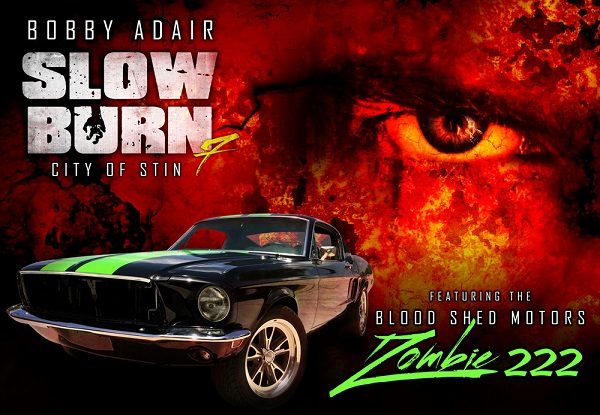
Source: Bobby Adair
ADH: Do you have a Zombie Apocalypse plan?
BA: NO. I do own a machete, and I’d like to buy an AR-15 because they’re fun to shoot. But going back to the accident prone thing, Kat (the wife) if [sic] afraid I’ll find someway [sic] to accidentally shoot myself with it if I get one. She might be right. That’ll leave me with aerobic fitness for escaping zombies. Not much of a plan, but its [sic] something.
ADH: What’s your favorite type of Zombie? Night of the Living Dead Zombie or World War Z?
BA: If there ever were real a zombie apocalypse, I have to go with the shufflers. I want to be able to outrun the.[sic] From an entertainment perspective, I go with fast zombies every time.
ADH: I’ve heard rumors of a possible TV deal for Slow Burn. Is that true?
BA: At this point, I think that is dead. I’d signed a contract with a company that was shopping Slow Burn around to some studios. There were some early, very positive signs but nothing every [sic] came of it and the contract expired. So, at this point, there’s nothing going happening.
ADH: Tell me about your bio-terrorism thriller, Ebola K.
BA: As I mentioned when answering a previous question, the story kind of had its beginnnings with my son’s experiences when he was volunteering in Africa. It grew into an Ebola story because I’ve been fascinated and a little terrified of Ebola since I first saw a series of stories about it on the news during the Zaire outbreak in the 70’s. I started researching and writing the summer before the latest outbreak in Africa. Those events influenced the book greatly as I chose to tie the plot to that outbreak.
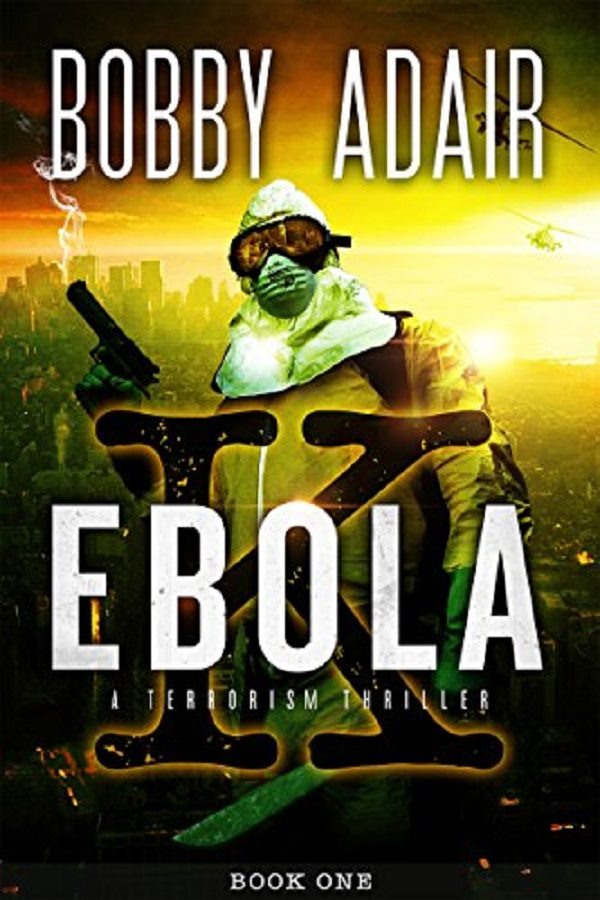
Source: Amazon
ADH: I understand that you did a great deal of research for this series. Did your research regarding the possibility of bioterrorism keep you awake at night?
BA: No. But going back to the question of whether I have a zombie apocalypse plan, I think I should, not necessarily for zombies but for the more likely possibilities. I think the two certainties that my research convinces me of are 1) a disaster will come, 2) some people will behave badly.
The disaster that comes might take the form of a natural disaster like a hurricane or a tsunami. These things happen all the time. People are seldom prepared for them, and when they happen on a large scale, governments have a hard time dealing with them.
The disaster might take the form of a pandemic. History is full of epidemics and pandemics. The only question is how many will die in the next one. If too many die, then social structures break down, a little at first, and more as things get worse.
Then there’s the chance of some sort of crippling terrorist attack, a power grid failure, a nuclear plant meltdown, heck an asteroid impact. All of these things happen all the time, the degree to which they affect our lives is a function of their proximity to where we live and their severity. Eventually, the odds will come up, and something will have an impact on our lives such that we’ll wish we had some extra food or flashlight batteries stored in the garage, maybe enough for a few days, maybe for a few weeks, maybe longer.
Then there’s the behavior of people. Most people behave honorably, kindly. But if you ever want to know how little some people value your life, get in your car during rush hour. Drive down the road at fifty or sixty and see a how many times other drivers do something stupid or malicious that if the circumstances were wrong, could get you killed. How many times has someone dangerously cut in front of you in traffic to save themselves one or two seconds? They put your life at risk to gain one or two seconds that they’ll lose at the next red light. How little value would these same people place on your life if a disaster came and you had a pantry full of food while their kids were going hungry?
ADH: You have many very prominent characters in Ebola K. Which one is your favorite?
BA: There are so many interesting characters in that series its hard to pick one. Most of them go through terrible circumstances and make some really tough choices. Paul Cooper, Austin Cooper, and Salim Pitafi are the most tortured of the bunch, so I probably like them the most.
ADH: Your newest series, Black Rust is also a virus-to-apocalypse book. How is this one different?
BA: I as trying to develop a unique post-apocalyptic world, not one with standard zombies, or some epidemic the killed everyone, or left the world a wasteland. I wanted a future where everything got kind of messed up by an epidemic, where society had to juggle itself around a bit, where some technologies progressed while others stagnated. But I wanted this world to be plausible, a place where my characters had to exist with a different set of rules, not the ones we live with today, and not the simple kill all the zombies rules. I was shooting for something completely different.
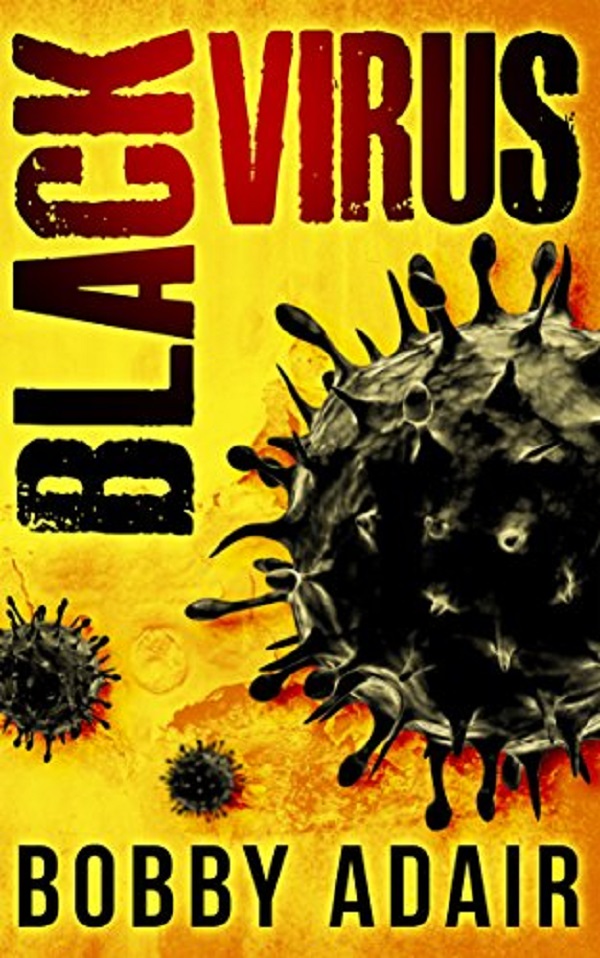
Source: Amazon
ADH: You introduce Christian Black in this series as a man trying to save his family in a chaotic, post-virus society. He seems to be very different from Zed in the Slow Burn series. Tell me a little about this character.
BA: Like Zed, Christian is flawed. I like anti-heroes more than the traditional ones. Christian is a bright kid with a talent for figuring things out, but also a kid who isn’t capable of making emotional connections with people. Because of that, the solutions he chooses for his problems are more imaginative, more pragmatic, and even more violent than those a normal person might choose.
ADH: Tell me a little about yourself. Did you always dream of becoming an author? Or is it a recent passion?
BA: As a kid my short list was astronaut, scientist, and writer. I’ve written on an off since then. I finished my first full-length novel when I was in my twenties, back in the late 80’s. I think I wrote four full novels and numerous short stories before I finally self-published the first one about a year before I wrote and published the first Slow Burn book.
ADH: What made you decide to write in this particular genre? Have you ever considered branching into other genres?
BA: I’ve always had an interest in zombies. I’ve always wanted to write a zombie book. I dabble in all the genres that I read. I like scifi and thrillers. Eventually, I’ll probably write more of those.
ADH: You churn out books so quickly. What’s your secret?
BA: It’s no secret. It’s hard work. My close friends think I’m a bit of a workaholic. I always feel like I’m not working hard enough. One friend of mine said I was the hardest working lazy man he’s ever met.
ADH: What does your writing area look like?
BA: I’ve got a second-hand table that I use for a desk, but it’s funky and cool. I work in a bedroom that’s converted to an office. I’ve got a tall window on one wall and a tall window in the hall just outside the door, so I’ve got good light. I’ve got a lot of pictures I want to hang on the wall but I’ve been in the house for a year, and I guess I’m too lazy to hang them. I’ve got one wall with four-foot tall glass panels mounted where I put post-notes that I use plotting out my books. The walls are dark gray, and the floor is dark wood.
ADH: Who’s your favorite author (living or dead)?
BA: Kurt Vonnegut.
ADH: Thank you so much for taking the time to answer my questions! It’s been a thrill to interview you. Any parting words?
BA: I’ve probably babbled on much more than anybody wants to read at this point so I’ll just say thanks.
Now that you’ve gotten to know the author, check out his books! They’re available in print and ebook through Amazon.
YouTube Channel: Bobby Adair
Featured image via Stuart Conover

